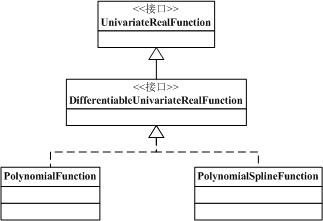Commons Math學(xué)習(xí)筆記——多項(xiàng)式函數(shù)
2.2 多項(xiàng)式函數(shù)
看其他篇章到目錄選擇。
在Commons Math中的analysis.polynomials包中有所有的與多項(xiàng)式函數(shù)相關(guān)的類和接口定義。這一篇主要從這個(gè)包分析,來研究一下多項(xiàng)式函數(shù)的應(yīng)用。

Polynomials包中沒有interface的定義,下屬含有5個(gè)類:PolynomialFunction、PolynomialFunctionLagrangeForm、PolynomialFunctionNewtonForm、PolynomialSplineFunction和PolynomialsUtils。其中主要的只有PolynomialFunction和PolynomialSplineFunction,正如api doc中的介紹,PolynomialFunction類是Immutable representation of a real polynomial function with real coefficients——實(shí)數(shù)多項(xiàng)式的表示;PolynomialSplineFunction類是Represents a polynomial spline function.——樣條曲線多項(xiàng)式的表示。另外兩個(gè)表示拉格朗日和牛頓形式的多項(xiàng)式函數(shù)。而PolynomialsUtils類中提供了幾個(gè)構(gòu)造個(gè)別(比如切比雪夫多項(xiàng)式)多項(xiàng)式的靜態(tài)方法。
我覺得最常用的應(yīng)該就是實(shí)數(shù)系數(shù)的多項(xiàng)式了,因此以PolynomialFunction類為例來進(jìn)行分析。實(shí)數(shù)系數(shù)的多項(xiàng)式函數(shù)形如:f(x) = ax^2 + bx + c。PolynomialFunction類實(shí)現(xiàn)了DifferentiableUnivariateRealFunction接口,因此必須實(shí)現(xiàn)value()和derivative()方法,并且實(shí)現(xiàn)該接口也表明這是一元可微分的實(shí)數(shù)函數(shù)形式。PolynomialFunction類定義了一組final double coefficients[]作為多項(xiàng)式系數(shù),其中coefficients[0]表示常數(shù)項(xiàng)的系數(shù),coefficients[n]表示指數(shù)為n的x^n次項(xiàng)的系數(shù)。因此,這個(gè)類所表達(dá)的多項(xiàng)式函數(shù)是這樣的:f(x)=coeff[0] + coeff[1]x + coeff[2]x^2 + … + coeff[n]x^n。它的構(gòu)造方法是PolynomialFunction(double [])就是接受這樣的coefficients數(shù)組作為系數(shù)輸入?yún)?shù)來構(gòu)造多項(xiàng)式的。這個(gè)是很好表達(dá)也很方便理解的。那么它的value(double x)方法是通過調(diào)用double evaluate(double[] coefficients, double argument)實(shí)現(xiàn)的,本質(zhì)用Horner's Method求解多項(xiàng)式的值,沒有什么技術(shù)難點(diǎn),非常好理解的一個(gè)給定參數(shù)和函數(shù)求值過程。剩余定義的一些加減乘等操作,都是通過一個(gè)類似public PolynomialFunction add(final PolynomialFunction p)這樣的結(jié)構(gòu)實(shí)現(xiàn)的。求導(dǎo)數(shù)的方法derivative()是通過這樣的一個(gè)微分操作實(shí)現(xiàn)的。見源碼:
 protected static double[] differentiate(double[] coefficients) {
protected static double[] differentiate(double[] coefficients) {2
 int n = coefficients.length;
int n = coefficients.length;3
 if (n < 1) {
if (n < 1) {4
 throw MathRuntimeException.createIllegalArgumentException("empty polynomials coefficients array");
throw MathRuntimeException.createIllegalArgumentException("empty polynomials coefficients array");5
 }
}6
 if (n == 1) {
if (n == 1) {7
 return new double[]{0};
return new double[]{0};8
 }
}9
 double[] result = new double[n - 1];
double[] result = new double[n - 1];10
 for (int i = n - 1; i > 0; i--) {
for (int i = n - 1; i > 0; i--) {11
 result[i - 1] = i * coefficients[i];
result[i - 1] = i * coefficients[i];12
 }
}13
 return result;
return result;14
 }
}15

測(cè)試代碼示例如下:
 /**
/**2
 *
* 3
 */
*/4
 package algorithm.math;
package algorithm.math;5

6
 import org.apache.commons.math.ArgumentOutsideDomainException;
import org.apache.commons.math.ArgumentOutsideDomainException;7
 import org.apache.commons.math.analysis.polynomials.PolynomialFunction;
import org.apache.commons.math.analysis.polynomials.PolynomialFunction;8
 import org.apache.commons.math.analysis.polynomials.PolynomialSplineFunction;
import org.apache.commons.math.analysis.polynomials.PolynomialSplineFunction;9

10
 /**
/**11
 * @author Jia Yu
* @author Jia Yu12
 * @date 2010-11-21
* @date 2010-11-2113
 */
*/14
 public class PolinomialsFunctionTest {
public class PolinomialsFunctionTest {15

16
 /**
/**17
 * @param args
* @param args18
 */
*/19
 public static void main(String[] args) {
public static void main(String[] args) {20
 // TODO Auto-generated method stub
// TODO Auto-generated method stub21
 polynomials();
polynomials();22
 System.out.println("-----------------------------------------------");
System.out.println("-----------------------------------------------");23
 polynomialsSpline();
polynomialsSpline();24
 }
}25

26
 private static void polynomialsSpline() {
private static void polynomialsSpline() {27
 // TODO Auto-generated method stub
// TODO Auto-generated method stub28
 PolynomialFunction[] polynomials = {
PolynomialFunction[] polynomials = {29
 new PolynomialFunction(new double[] { 0d, 1d, 1d }),
new PolynomialFunction(new double[] { 0d, 1d, 1d }),30
 new PolynomialFunction(new double[] { 2d, 1d, 1d }),
new PolynomialFunction(new double[] { 2d, 1d, 1d }),31
 new PolynomialFunction(new double[] { 4d, 1d, 1d }) };
new PolynomialFunction(new double[] { 4d, 1d, 1d }) };32
 double[] knots = { -1, 0, 1, 2 };
double[] knots = { -1, 0, 1, 2 };33
 PolynomialSplineFunction spline = new PolynomialSplineFunction(knots,
PolynomialSplineFunction spline = new PolynomialSplineFunction(knots,34
 polynomials);
polynomials);35
 //output directly
//output directly36
 System.out.println("poly spline func is "+spline);
System.out.println("poly spline func is "+spline);37
 // get the value when x = 0.5
// get the value when x = 0.538
 try {
try {39
 System.out.println("f(0.5) = "+spline.value(0.5));
System.out.println("f(0.5) = "+spline.value(0.5));40
 } catch (ArgumentOutsideDomainException e) {
} catch (ArgumentOutsideDomainException e) {41
 // TODO Auto-generated catch block
// TODO Auto-generated catch block42
 e.printStackTrace();
e.printStackTrace();43
 }
}44
 // the number of spline segments
// the number of spline segments45
 System.out.println("spline segments number is "+spline.getN());
System.out.println("spline segments number is "+spline.getN());46
 // the polynomials functions
// the polynomials functions47
 for(int i=0;i<spline.getN();i++){
for(int i=0;i<spline.getN();i++){48
 System.out.println("spline:f"+i+"(x) = "+spline.getPolynomials()[i]);
System.out.println("spline:f"+i+"(x) = "+spline.getPolynomials()[i]);49
 }
}50
 //function derivative
//function derivative51
 System.out.println("spline func derivative is "+spline.derivative());
System.out.println("spline func derivative is "+spline.derivative());52
 }
}53

54
 private static void polynomials() {
private static void polynomials() {55
 // TODO Auto-generated method stub
// TODO Auto-generated method stub56
 double[] f1_coeff = { 3.0, 6.0, -2.0, 1.0 };
double[] f1_coeff = { 3.0, 6.0, -2.0, 1.0 };57
 double[] f2_coeff = { 1.0, 2.0, -1.0, -2.0 };
double[] f2_coeff = { 1.0, 2.0, -1.0, -2.0 };58
 PolynomialFunction f1 = new PolynomialFunction(f1_coeff);
PolynomialFunction f1 = new PolynomialFunction(f1_coeff);59
 PolynomialFunction f2 = new PolynomialFunction(f2_coeff);
PolynomialFunction f2 = new PolynomialFunction(f2_coeff);60
 // output directly
// output directly61
 System.out.println("f1(x) is : " + f1);
System.out.println("f1(x) is : " + f1);62
 System.out.println("f2(x) is : " + f2);
System.out.println("f2(x) is : " + f2);63
 // polynomial degree
// polynomial degree64
 System.out.println("f1(x)'s degree is " + f1.degree());
System.out.println("f1(x)'s degree is " + f1.degree());65
 // get the value when x = 2
// get the value when x = 266
 System.out.println("f1(2) = " + f1.value(2));
System.out.println("f1(2) = " + f1.value(2));67
 // function add
// function add68
 System.out.println("f1(x)+f2(x) = " + f1.add(f2));
System.out.println("f1(x)+f2(x) = " + f1.add(f2));69
 // function substract
// function substract70
 System.out.println("f1(x)-f2(x) = " + f1.subtract(f2));
System.out.println("f1(x)-f2(x) = " + f1.subtract(f2));71
 // function multiply
// function multiply72
 System.out.println("f1(x)*f2(x) = " + f1.multiply(f2));
System.out.println("f1(x)*f2(x) = " + f1.multiply(f2));73
 // function derivative
// function derivative74
 System.out.println("f1'(x) = " + f1.derivative());
System.out.println("f1'(x) = " + f1.derivative());75
 System.out.println("f2''(x) = "
System.out.println("f2''(x) = "76
 + ((PolynomialFunction) f2.derivative()).derivative());
+ ((PolynomialFunction) f2.derivative()).derivative());77

78
 }
}79

80
 }
}81

輸出如下:
f1(x) is : 3.0 + 6.0 x - 2.0 x^2 + x^3
f2(x) is : 1.0 + 2.0 x - x^2 - 2.0 x^3
f1(x)'s degree is 3
f1(2) = 15.0
f1(x)+f2(x) = 4.0 + 8.0 x - 3.0 x^2 - x^3
f1(x)-f2(x) = 2.0 + 4.0 x - x^2 + 3.0 x^3
f1(x)*f2(x) = 3.0 + 12.0 x + 7.0 x^2 - 15.0 x^3 - 8.0 x^4 + 3.0 x^5 - 2.0 x^6
f1'(x) = 6.0 - 4.0 x + 3.0 x^2
f2''(x) = -2.0 - 12.0 x
-----------------------------------------------
poly spline func is org.apache.commons.math.analysis.polynomials.PolynomialSplineFunction@69b332
f(0.5) = 2.75
spline segments number is 3
spline:f0(x) = x + x^2
spline:f1(x) = 2.0 + x + x^2
spline:f2(x) = 4.0 + x + x^2
spline func derivative is org.apache.commons.math.analysis.polynomials.PolynomialSplineFunction@173a10f
PolynomialFunction類也是重寫了toString方法和hashCode和equals方法的。
PolynomialSplineFunction類是多項(xiàng)式樣條函數(shù),樣條是一種特殊的函數(shù),由多項(xiàng)式分段定義。表示了一個(gè)由多個(gè)多項(xiàng)式組成的樣條曲線。它的實(shí)現(xiàn)主要是內(nèi)部定義了一個(gè)多項(xiàng)式函數(shù)組PolynomialFunction polynomials[]和一個(gè)樣條分界節(jié)點(diǎn)數(shù)組double knots[]。這兩個(gè)內(nèi)部成員分別表示什么呢?分界節(jié)點(diǎn)表示整條曲線對(duì)應(yīng)在x等于knots[i]的時(shí)候開始使用其他多項(xiàng)式樣條,其構(gòu)造方法public PolynomialSplineFunction(double knots[], PolynomialFunction polynomials[])完成這樣的功能。
舉例來說,一個(gè)多項(xiàng)式樣條函數(shù)就是一個(gè)分段函數(shù):
X^2+x [-1,0)
F(x) = x^2+x+2 [0,1)
X^2+x+4 [1,2)
當(dāng)然,構(gòu)造方法中的參數(shù),knots[]數(shù)組必須是遞增的。
可以看到,直接輸出PolynomialSplineFunction是多么丑陋啊~~,因?yàn)樗鼪]有重寫toString方法。同樣,它的導(dǎo)數(shù)也是一樣的丑陋。其中如果給定的值不在定義域內(nèi),value方法還拋出異常ArgumentOutsideDomainException。
最后PolynomialFunctionLagrangeForm和PolynomialFunctionNewtonForm類完成的其實(shí)是多項(xiàng)式插值的功能,放到下一節(jié)研究的。
相關(guān)資料:
樣條函數(shù):http://zh.wikipedia.org/zh-cn/%E6%A0%B7%E6%9D%A1%E5%87%BD%E6%95%B0
Horner Methods:http://mathworld.wolfram.com/HornersMethod.html
Commons math包:http://commons.apache.org/math/index.html
posted on 2010-12-15 10:48 changedi 閱讀(2929) 評(píng)論(0) 編輯 收藏 所屬分類: 數(shù)學(xué)




